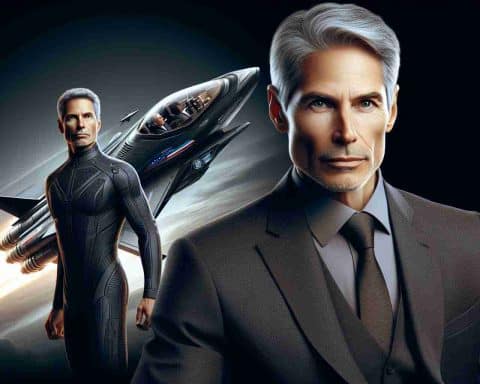In the heyday of stealth technology and cutting-edge aviation, the Northrop YF-23 emerged as a pioneering yet overlooked marvel. Developed in the 1980s and early 1990s, the YF-23 was Northrop’s contender in the Advanced Tactical Fighter (ATF) competition, a program initiated by the United States Air Force to develop the next generation of air superiority fighters.
The YF-23, known by its nicknames “Black Widow II” and “Gray Ghost,” was a stealth, twin-engine fighter that competed against Lockheed Martin’s YF-22. Out of this fierce competition, the YF-22 was ultimately chosen to become the F-22 Raptor, but the YF-23 left a lasting impact on military aviation enthusiasts and engineers.
Featuring a sleek, diamond-shaped wing design and a focus on stealth and speed, the YF-23 demonstrated impressive capabilities. It had two operational prototypes, designated as PAV-1 and PAV-2, each equipped with different engines: the Pratt & Whitney YF119 and the General Electric YF120, respectively. The design emphasized high-speed, stealth, and long-range engagements, with the capability to achieve near-supersonic speeds without afterburners – a feature known as “supercruise.”
Although the YF-23 didn’t enter production, its development contributed to advancements in aerodynamics, stealth technology, and propulsion systems. Today, the remaining prototypes are treasured museum pieces, symbolizing a chapter of what might have been in aviation history. Rediscovering the YF-23 invites aviation enthusiasts and history buffs alike to appreciate its role in shaping the future of military aviation.
The Untold Legacy of the Northrop YF-23: A Marvel Beyond the Skies
In the shadows of aviation history lies the unsung hero, the Northrop YF-23, a stealth fighter whose influence extends beyond its untimely dismissal. Although the YF-23 lost the Advanced Tactical Fighter competition to the YF-22, its legacy persists in unexpected ways. How does this influence ripple through modern aviation and defense industries?
One intriguing aspect is the YF-23’s contribution to stealth technology beyond obvious military applications. Its aerodynamic designs and stealth strategies have inspired innovations in civilian sectors, including emergent UAV (unmanned aerial vehicle) technology. Why is this significant? The transfer of this technology has allowed for the development of drones that are not only stealthier but also more efficient in terms of fuel consumption and payload capabilities.
Communities and industries indirectly benefit from this technological seepage. Enhanced UAV technology has enabled more effective disaster response operations, precision agriculture, and environmental monitoring. For countries focusing on innovative industries, these advancements underpin economic diversification and technological leadership.
Despite the YF-23 never reaching mass production, it triggered debates about military procurement practices and priorities. A pressing question arises: Should cutting-edge breakthroughs be sidelined due to economic or strategic choices? This controversy prompts ongoing discussions about balancing innovation with strategic procurement, highlighting the complexities of defense development programs.
For those intrigued by this stealth fighter’s enduring impact, exploring organizations like the Northrop Grumman could provide deeper insights into how past aviation marvels continue to influence modern advancements, both in military and civilian domains.
The article has been updated: 2024-11-08 03:10
Here are some suggested related links to include in your post:
1. The Northrop Grumman Official Site – Explore the innovations and history of Northrop Grumman, the manufacturer of the YF-23 and other cutting-edge technologies in aerospace and defense.
2. Aviation Week – A leading source of news and insights on the aerospace industry, including articles on military aircraft like the YF-23 and its significance in aviation history.
3. The U.S. Air Force – Discover the roles and history of various aircraft in the U.S. Air Force, including details about fighter jets and stealth technology.
4. Military.com – A comprehensive resource for military news and history, providing information on various aircraft platforms, including the Northrop YF-23.
5. Defense News – Stay updated with the latest developments in defense and military technology, including features on historical aircraft like the YF-23.
6. GlobalAir.com – An aviation directory that includes news, insights, and data on various aircraft, featuring important information related to the YF-23’s design and specifications.
7. FlightGlobal – A leading international aviation publication offering news, analysis, and information about all types of military aircraft, including the YF-23.
8. Air & Space Magazine – A publication dedicated to aviation and space exploration, providing in-depth articles about aircraft and profiles of historical models like the YF-23.
The article has been updated: 2024-11-08 16:36
What were the key features and innovations of the Northrop YF-23 that set it apart in the development of stealth fighter aircraft?
The Northrop YF-23, a prototype developed for the United States Air Force’s Advanced Tactical Fighter program, showcased several key features and innovations that distinguished it from other aircraft of its time. Its unique design incorporated advanced stealth technology, with a radical airframe shape and the use of radar-absorbent materials, which significantly reduced its radar cross-section. The YF-23 also featured a pair of innovative nacelles housing dual-engine turbines, allowing for supercruise capability—enabling it to fly at supersonic speeds without afterburners, thus increasing efficiency and reducing infrared signatures.
Additionally, the aircraft was equipped with an advanced flight control system, enhancing its maneuverability and operational capabilities. The distinctive diamond-wing shape contributed to its agility and aerodynamic performance, making it an impressive contender over its rival, the Lockheed YF-22, in the competition. Ultimately, while the YF-23 did not enter production, its technological advancements influenced future stealth aircraft designs, solidifying its legacy in aviation history.

















